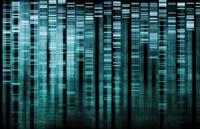Value or uselessness of personal genomes

Some time ago a computer professor explained to me that data and information were not the same, that information could be obtained from the data, but that the raw data, especially when the number of data is very high, are not informative. A succession of 3,000,000,000 letters (the sequence of our genome is composed of so many bases) serves little, while someone does not interpret that sequence. Therefore, we must convert the data (sequence) into information to serve us. And for this we should know the effect that the sequence changes that occur in the genome have on humans. This raises a second question. How will the sequences of our genes be? Is our destiny written in our genome?
Although the development of genetics may seem deterministic, it is not so. All of us who work in genetics are clear that to some extent our genes fix our phenotype, that is, how we are from outside, whether or not we suffer genetic diseases, etc. But we also have clear that the medium can have a great influence on the formation of the phenotype. One example of this is the monozygotic twins: although the genomic sequence is the same, they are not equal and do not always develop the same diseases and genetic characteristics. Their responsibility is the environment.
Genetic impact measurement
The key is precisely there, knowing the influence of genes and the medium for each feature. There are certain characteristics in which the medium will have little incidence (in these cases our genes are responsible for the phenotype, for example in Down syndrome), and others in which genetic agents will have a lower incidence in the appearance of the disease, while the medium is high (for example, in cancer). In the first case, the genome sequence will determine whether we will be sick or healthy and, therefore, once the sequence is known, our diagnosis will be accurate. In the second case, however, the diagnosis will not be safe, that is, we can only determine a probability of developing the disease without knowing if we will actually develop it or not. In view of this, the third question that can be posed is if we were able to fix the influence of the medium on each characteristic, would the information of our genome be useful?
Even knowing the influence of the medium, it would be necessary to know all the sequences that produce a certain disease in order to make a concrete diagnosis, and for this we should know all the variability existing in the different human beings. And that is not yet known. When the human genome was sequenced, the genomes of five people were mixed, which was what sequenced. This does not mean that the genomic sequences of all human beings were represented in that genomic mixture. Therefore, we still need to know better the diversity of the human genome sequence.
It is true that in many genetic diseases the causative sequences are known, but in complex diseases we still do not have this information, such as cancer, or in other cases: obesity, hypertension... We do not know all the sequences that can influence the appearance of complex diseases and to what extent each of them can cause the disease. It is quite clear that our genome affects complex diseases, but it is almost impossible to imagine whether a particular person will be ill or healthy, based solely on their genetic information.
On the other hand, if the study of our genome indicates that we have a low risk of having a certain disease (for example, heart problems), we risk sending another message: "Quiet, don't get sick, so don't take care of yourself." And this is also a misleading and dangerous message because not having a genetic agent of disease means you won't have any disease.
Therefore, and to summarize, the last question is: Is this the time of individual genetics?
I think we are still at the time of genome research. We must not forget that the sequencing of the human genome ended in 2003 and that we still do not understand the complexity of the genome (we still do not know the number of genes in the genome).
All the data so far makes us think that it is not too valuable to know our genetic information. The truth is that, except for certain diseases, we cannot make concrete forecasts. Genetic information only serves to make reliable predictions of diseases little impacted by the environment, that is, of monogenetic diseases, and not always.
We are still at the time of research, and maybe within three years I will have to change what was said here, but I don't believe. Let us not make predictions that we will not fulfill. The time will come when the genetic information of each one will be important, and then we will have to regulate what to do, to whom to put the information... But that is another debate.






